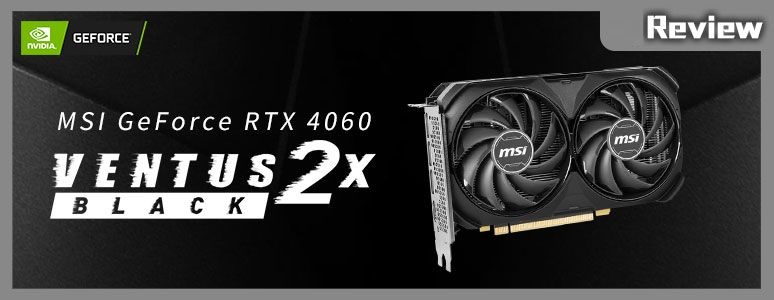
Would the RTX 3060 Ti be required to step in again? The much-anticipated 1080p entry-level gaming card, the “NVIDIA GeForce RTX 4060”, is set to launch before summer break, fulfilling the gaming performance requirements for entry-level FHD resolution gaming, AAA, and ray tracing masterpieces. With a starting price of $10,690 in Taiwan, it is currently the most affordable gaming card featuring DLSS 3 acceleration technology. Despite the RTX 4060 boasting a 20% performance boost over its predecessor, its price point is uncomfortably close to the yet-to-be-phased-out RTX 3060 Ti. The question remains – who will pick up the tab!
From NT$10,690! NVIDIA GeForce RTX 4060 8GB is here!
The robust and energy-efficient NVIDIA GeForce RTX 4060 8GB gaming graphics card provides an 8-fold gaming performance boost compared to the older GTX 1060 and a 1.6-fold improvement over the RTX 2060. The original RTX 3060 experiences a 1.2-fold raw performance enhancement, and with DLSS 3 acceleration included, it can achieve up to 1.7 times gaming performance upgrade.
The GeForce RTX 4060 employs the Ada Lovelace architecture, TSMC’s 4N process, and the AD107 GPU. It’s packed with 24 SM units, 3072 CUDA cores, 96 Tensor cores, and 24 RT cores. The GPU Boost clock reaches 2460MHz, and it comes with 8GB GDDR6 memory, a 128-bit interface, a rate of 17 Gbps, and a bandwidth of 272GB/s.
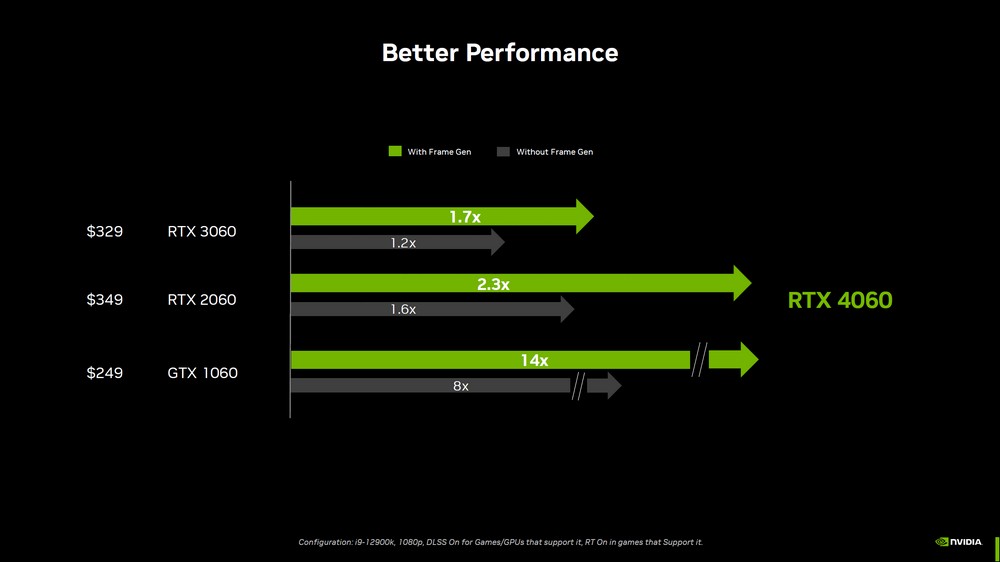
In terms of power usage, the RTX 4060’s Total Graphics Power (TGP) is just 115W, and its average in-game power consumption is 110W. It only requires one PCIe 8-pin power source, a decrease in power usage compared to its predecessor. Thoughtfully, NVIDIA has also calculated the potential energy consumption for gamers. If one plays for 10-20 hours per week, the RTX 4060 only requires 1.1-2.2kWh, while the RTX 3060 requires 1.7-3.4kWh. Over four years of gaming, this could indeed translate into significant savings on electricity bills. Nonetheless, gamers tend to prioritize performance per dollar over power efficiency.
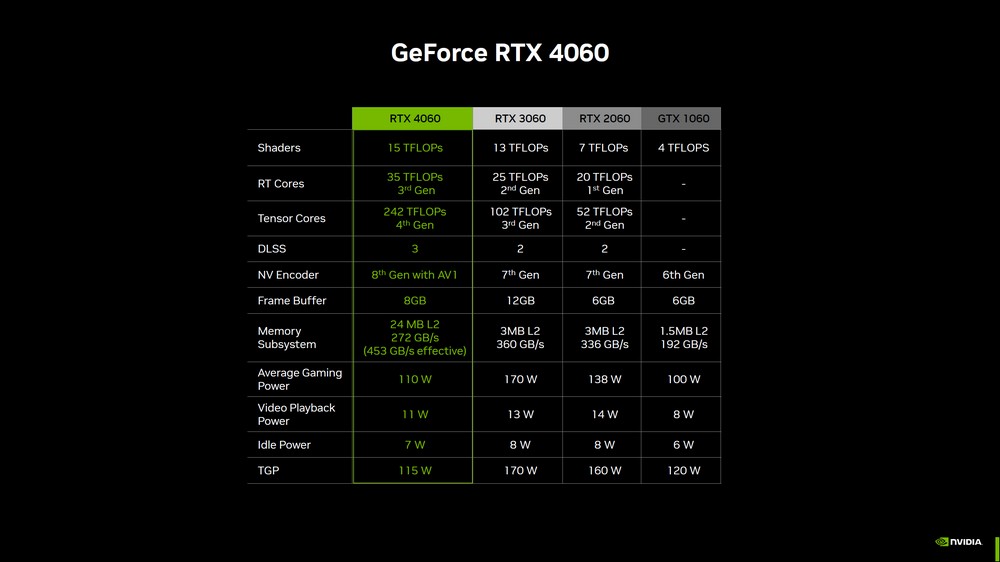
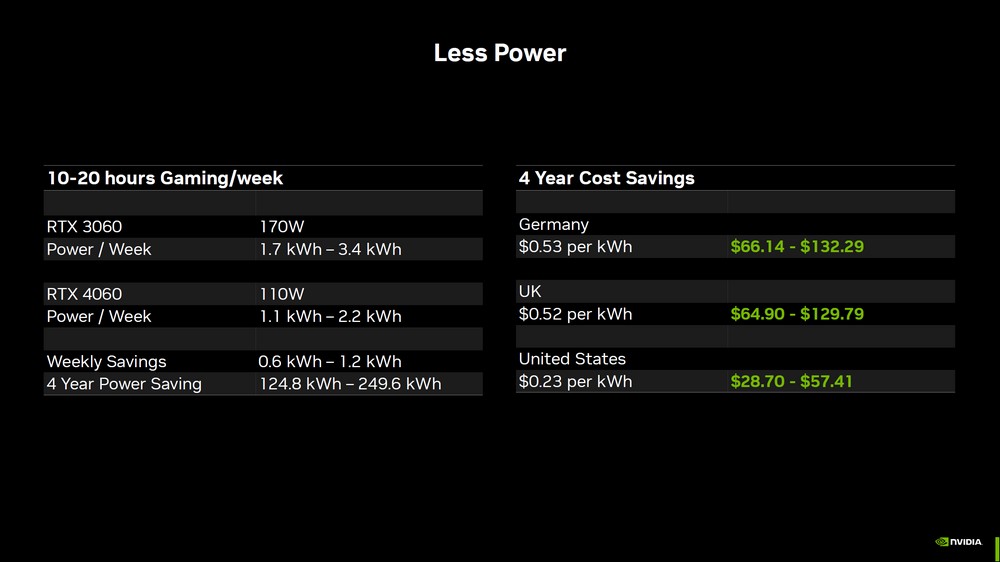
MSI GeForce RTX 4060 Ventus 2X Black 8G OC out of the box / Mini ITX graphics card 19cm, 2-slot
This review utilizes the MSI GeForce RTX 4060 Ventus 2X Black 8G OC graphics card, a compact 19cm, two-fan, dual-slot thick graphics card. The dual fans employ TORX FAN 4.0 technology, linking two sets of fan blades to form an external frame that enhances cooling airflow. The back of the graphics card features a molded plastic backplate, and cooling vents are placed at the front to increase internal case airflow.
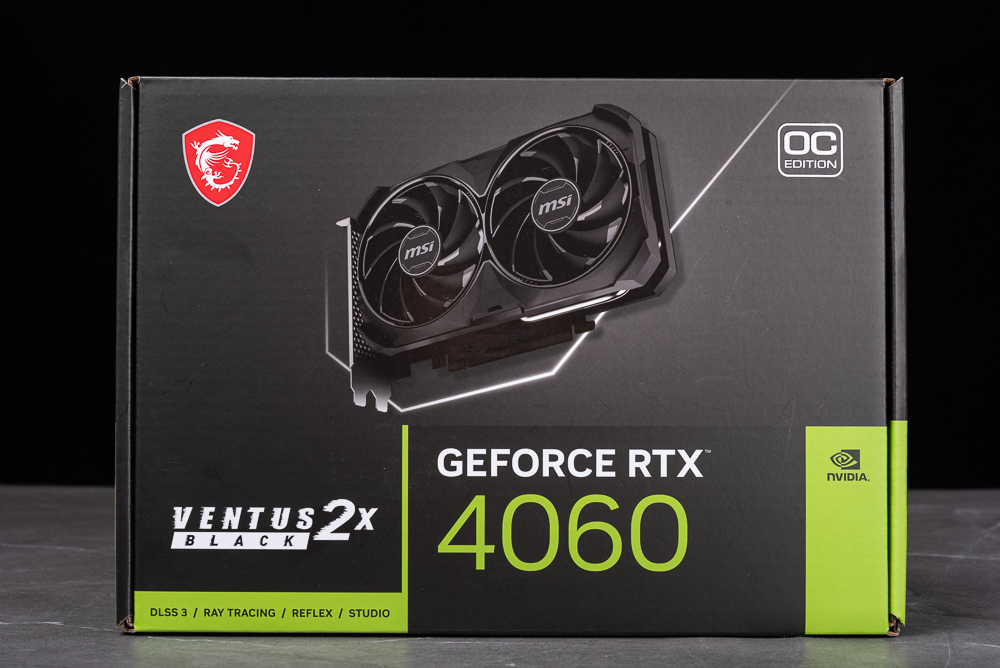
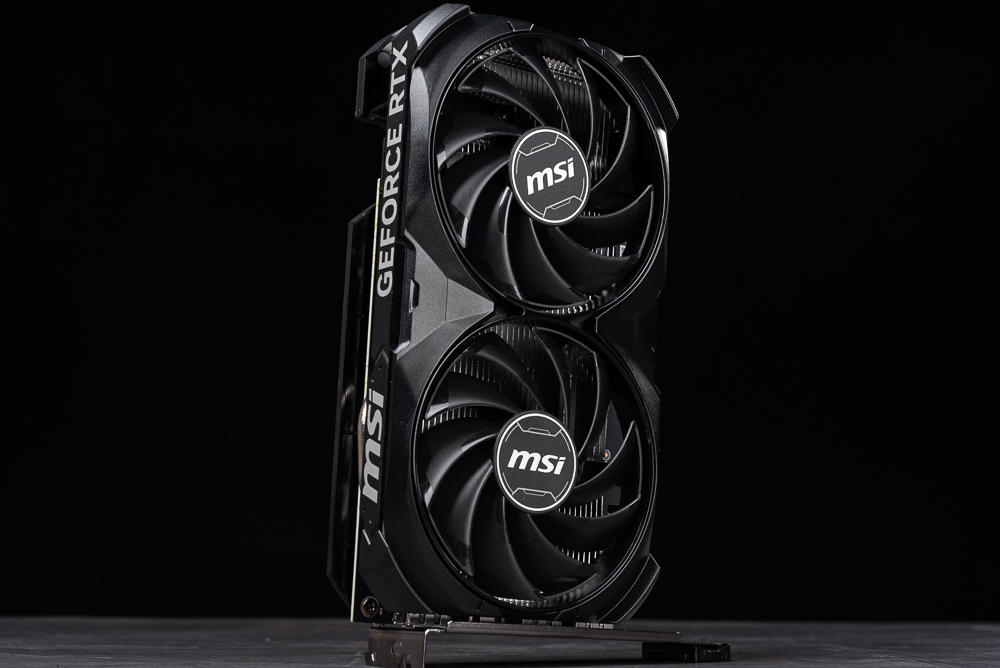
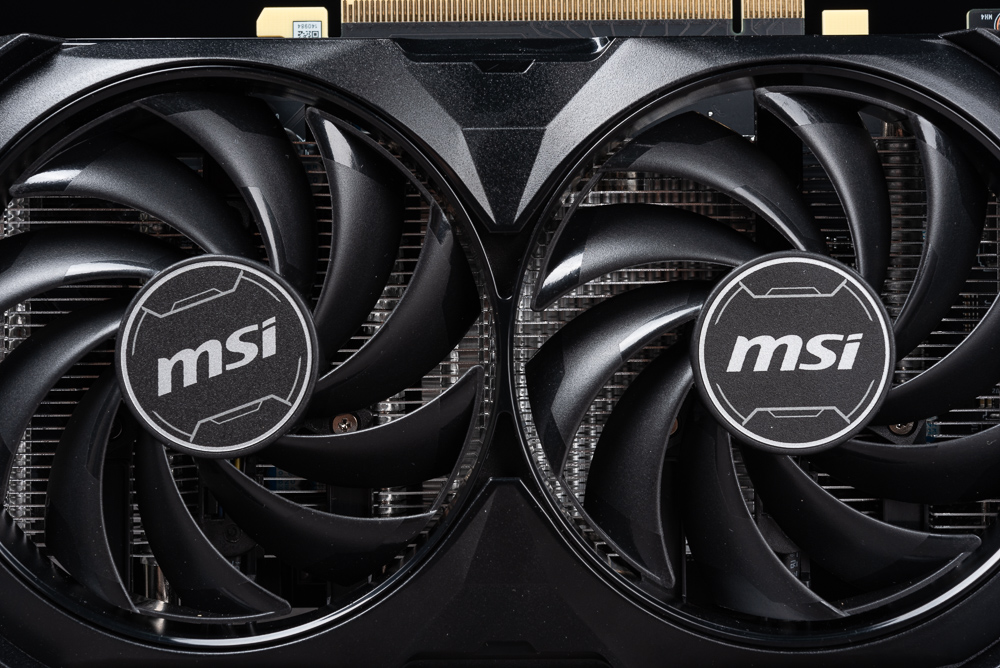
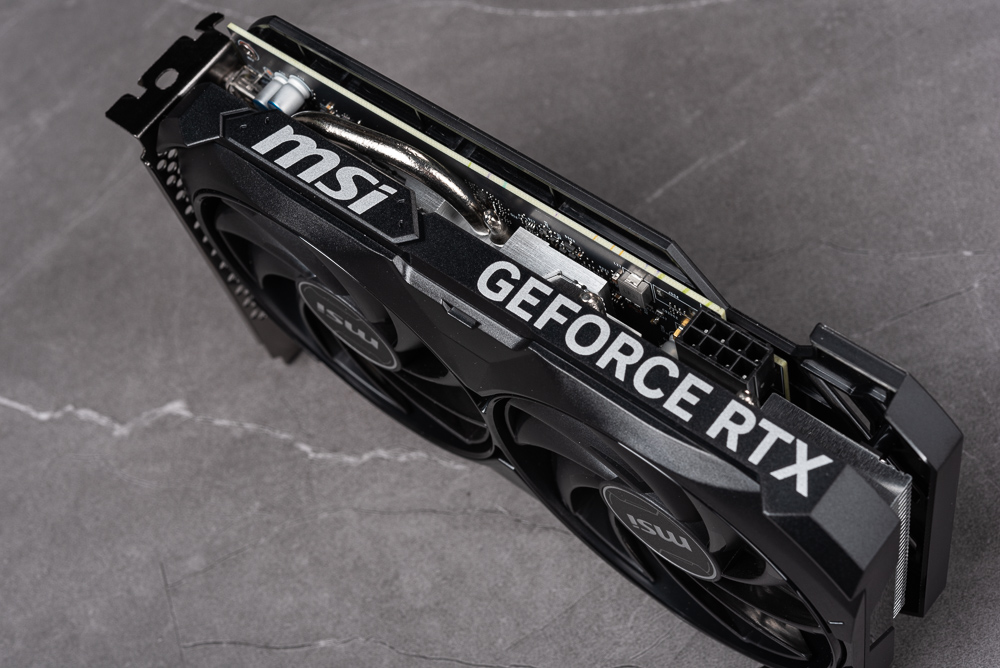
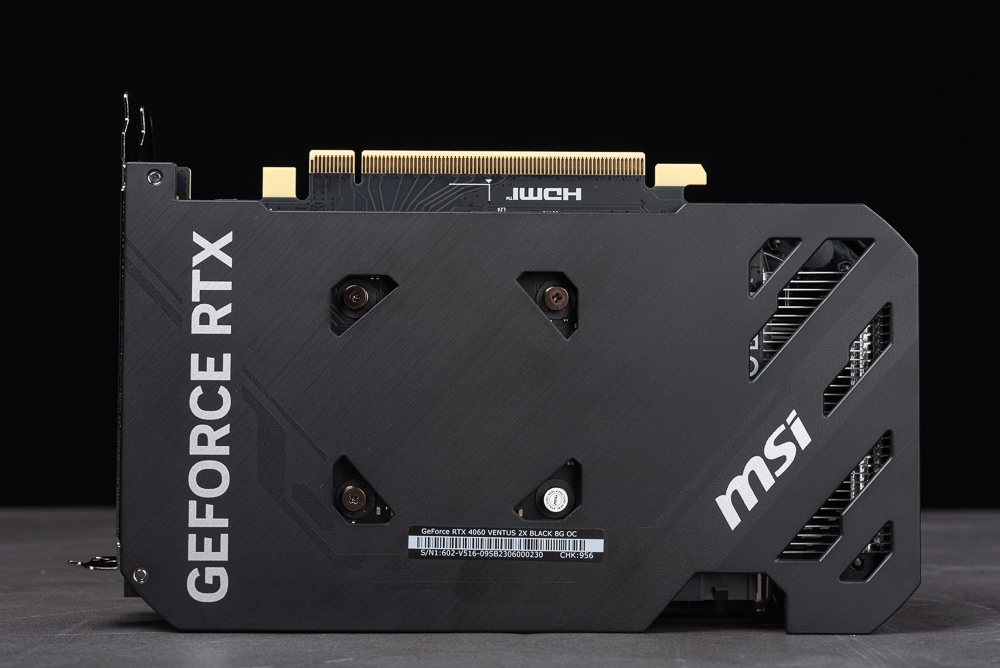
The graphics card offers 3 DisplayPort 1.4a and 1 HDMI 2.1a port, supporting a maximum of four screens. With a single PCIe 8-pin for power, the compact and cost-effective RTX 4060 presents itself as a viable option for gamers looking to upgrade or assemble an ITX mini-rig.
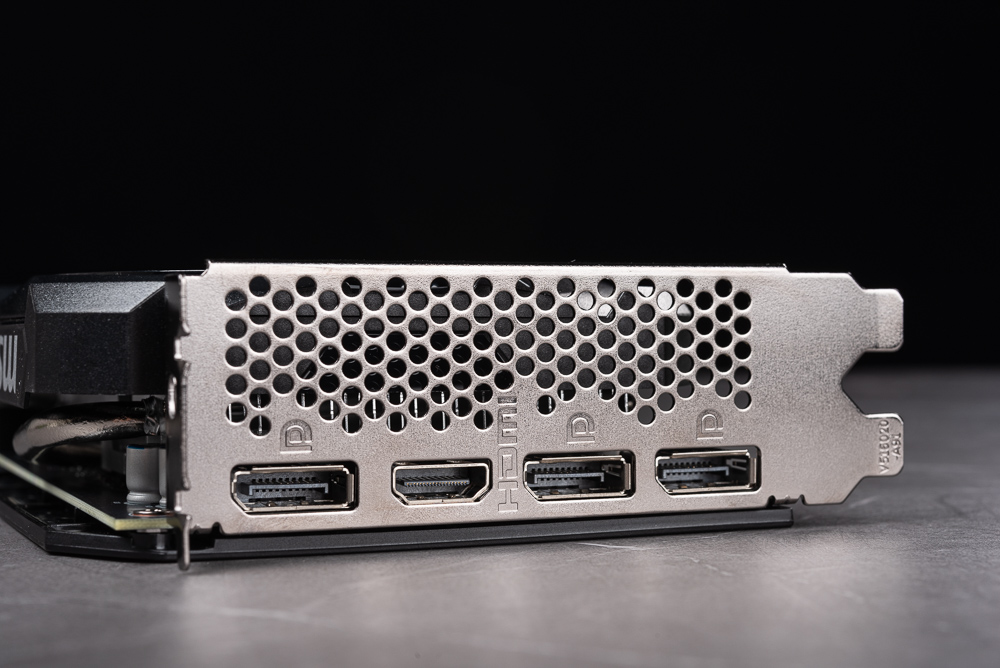
The RTX 4060 Ventus 2X Black 8G OC employs the AD107 GPU, paired with four Hynix GDDR6 memory chips to make up its 8GB capacity. The cooling system utilizes two heat pipes that directly contact the GPU and run through the cooling fins in an S-shaped configuration.
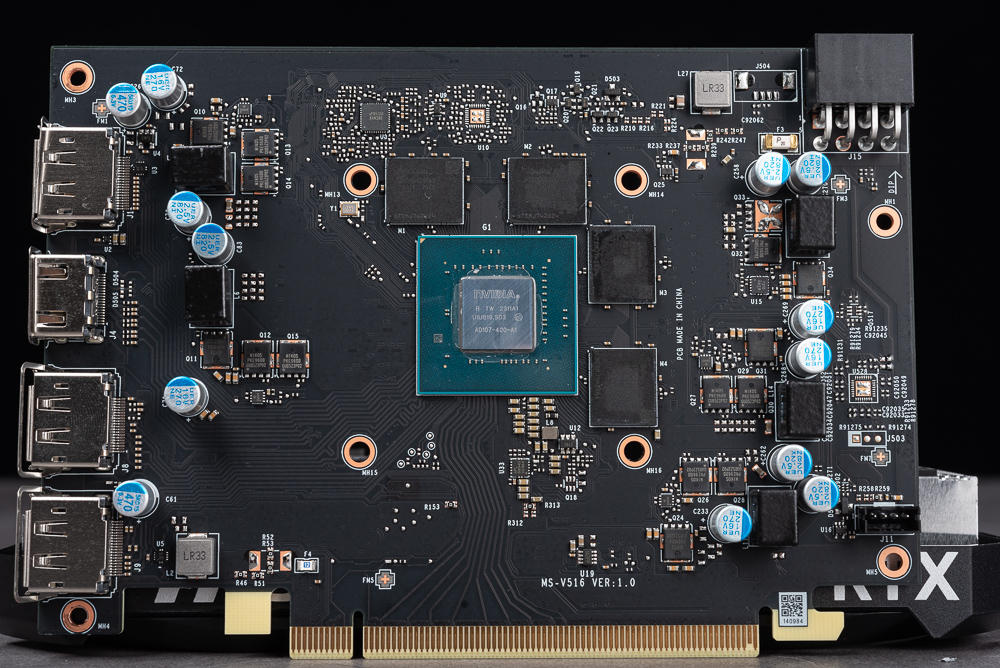
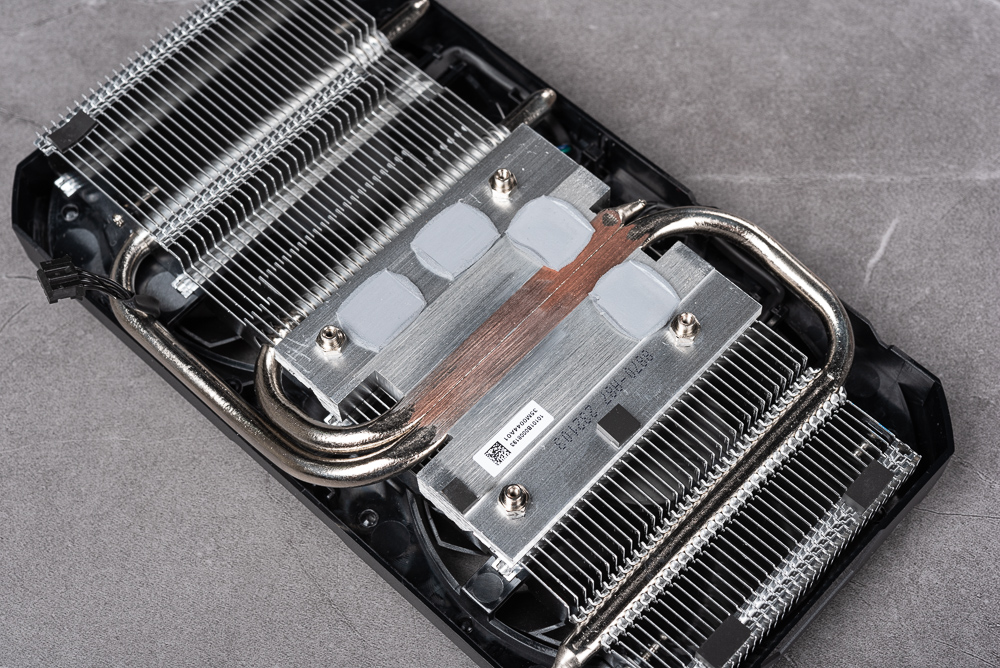
RTX 4060 Ventus 2X Black 8G OC – 3DMark Benchmark Performance Test
This review concentrates on testing games at 1080p and 1440p resolutions, with the highest visual effects presets enabled. It compares the performance of e-sports, AAA, and ray tracing games utilizing DLSS 3 acceleration with that of the RTX 4060 Ti 8GB, RTX 3060 Ti 8GB, RTX 3060 12GB, and RX 7600 8GB. This allows gamers to have a broader data reference when making their initial selections.
Test Platform
Processor: Intel Core i9-13900K
Motherboard: ASUS ROG MAXIMUS Z790 HERO
Memory: Corsair DOMINATOR PLATINUM RGB DDR5 5600 32GBx2
Display Card: RTX 4060 Ti 8GB, RTX 4060, RTX 3060 Ti, RX 7600
System Disk: Solidigm P44 Pro 1TB PCIe 4.0 SSD
Radiator: ASUS ROG RYUJIN III 360
Power Supply: Seasonic FOCUS GX (ATX3.0) 750W
Operating System: Windows 11 Pro 21H2 64bit, Resizable BAR On
Driver Version: NVIDIA 536.20, AMD
GPU-Z inspects the specifics of the NVIDIA GeForce RTX 4060. The AD107 GPU utilizes a 5nm process, comes with 3072 rendering CUDA cores, and has 8192 MB of GDDR6 (Hynix) memory. The GPU’s default clock frequency is set at 1830 MHz and can boost up to 2490 MHz.
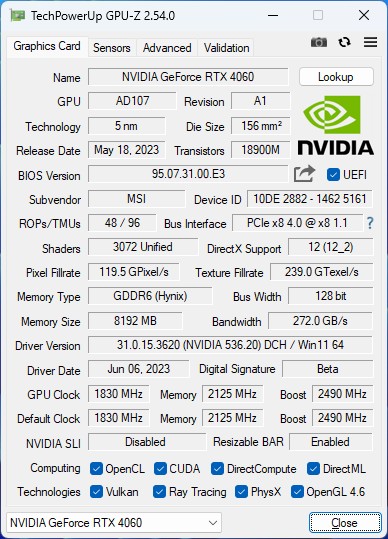
The 3DMark Fire Strike performance test is a mainstream DirectX 11 API testing scenario, evaluating performance at 1080p, Extreme 1440p, and Ultra 2160p respectively.
In the Fire Strike benchmark, the RTX 4060 scored 28599 points at 1080p, 13392 points at Extreme 1440p, and 5790 points at Ultra 2160p. Compared to the RTX 3060 12GB, the RTX 4060 exhibited an average improvement of 24% in graphic performance. However, it trailed the RTX 3060 Ti 8GB by about -13% in graphic performance and fell short by about -11% compared to the RX 7600 in benchmark scores. As for the preceding RTX 4060 Ti, it exhibited a -18% performance difference.
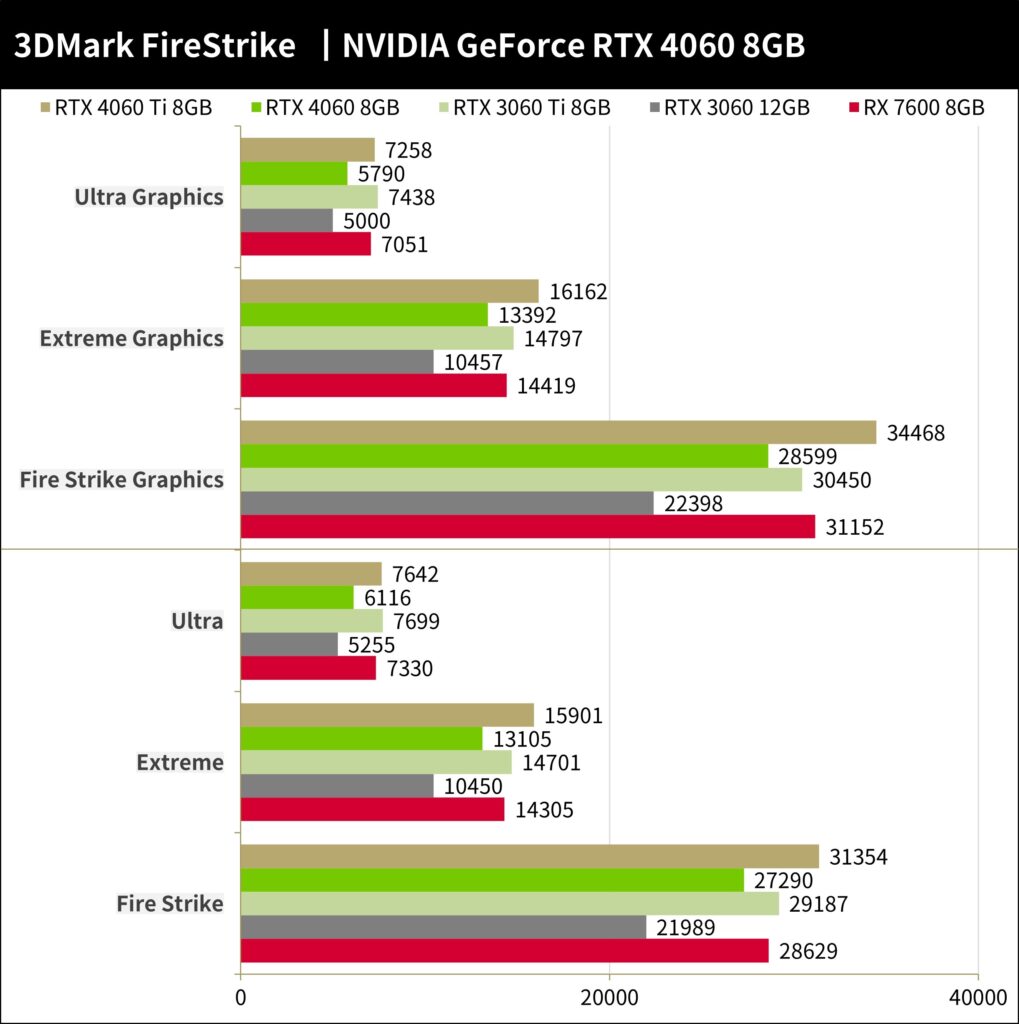
3DMark Time Spy is a benchmark scenario designed using the DirectX 12 API, and is fixed at the AAA game level to assess performance at 1440p and Extreme 2160p respectively.
In the Time Spy benchmark, the RTX 4060 scored 10742 points at 1440p and 5011 points at Extreme 2160p. Compared to the RTX 3060 12GB, the RTX 4060 exhibited an average improvement of 23% in graphic performance. However, it lagged behind the RTX 3060 Ti 8GB by about -12% in graphic performance and fell short by about -2% compared to the RX 7600 in benchmark scores. Regarding the preceding RTX 4060 Ti, it exhibited a -21% performance difference.
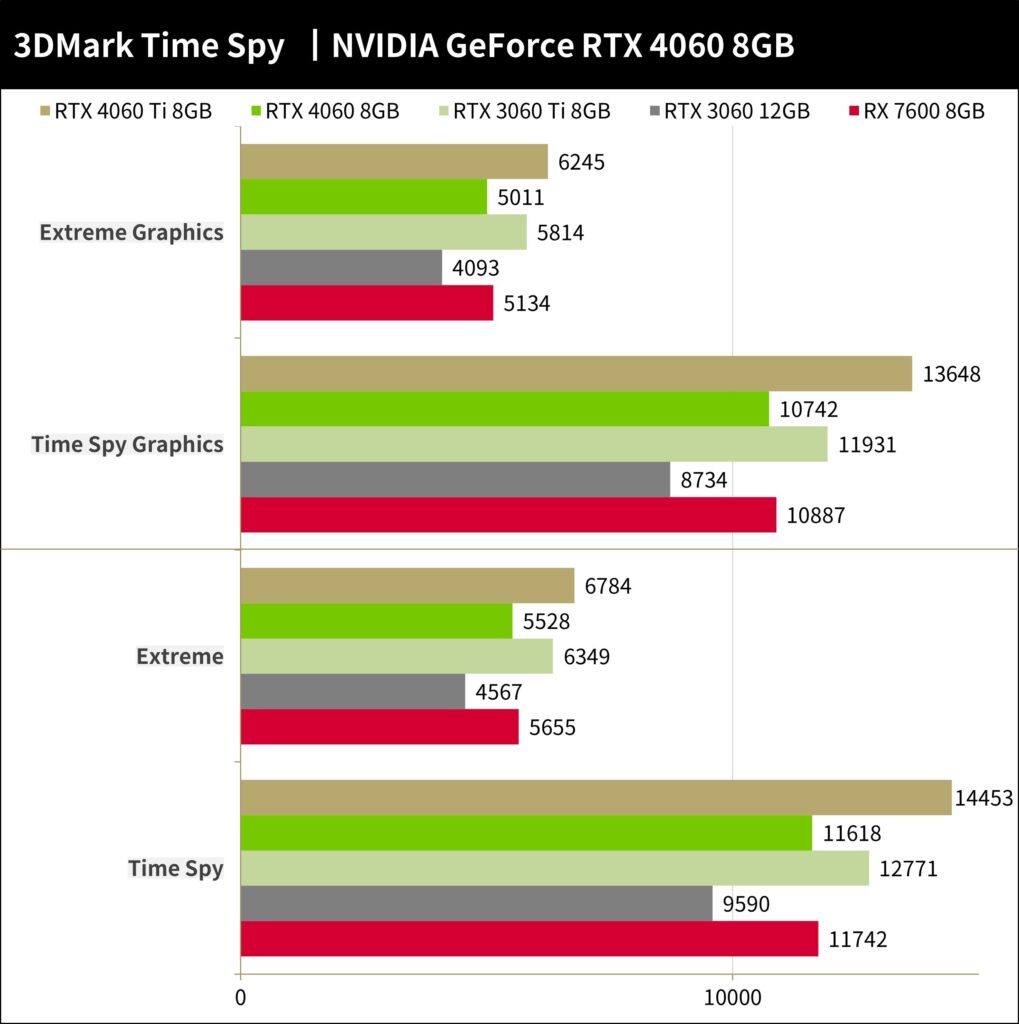
For the ray tracing test, 3DMark Port Royal incorporates ray tracing features into AAA game scenes, testing the capabilities of the new generation GPU in accelerating hardware ray tracing. Concurrently, the DXR test uses the DirectX Raytracing API in a functional test; Speed Way is a test scenario developed using full ray tracing.
Running without DLSS, the RTX 4060 scored 28.17 FPS in Port Royal, 27.11 FPS in DXR, and 25.39 FPS in Speed Way. Compared to the RTX 3060 12GB, the RTX 4060’s ray tracing performance improved by an average of 24%. However, it lagged behind the RTX 3060 Ti 8GB by -9% in graphics performance. The RX 7600 is about 27% ahead in ray tracing.
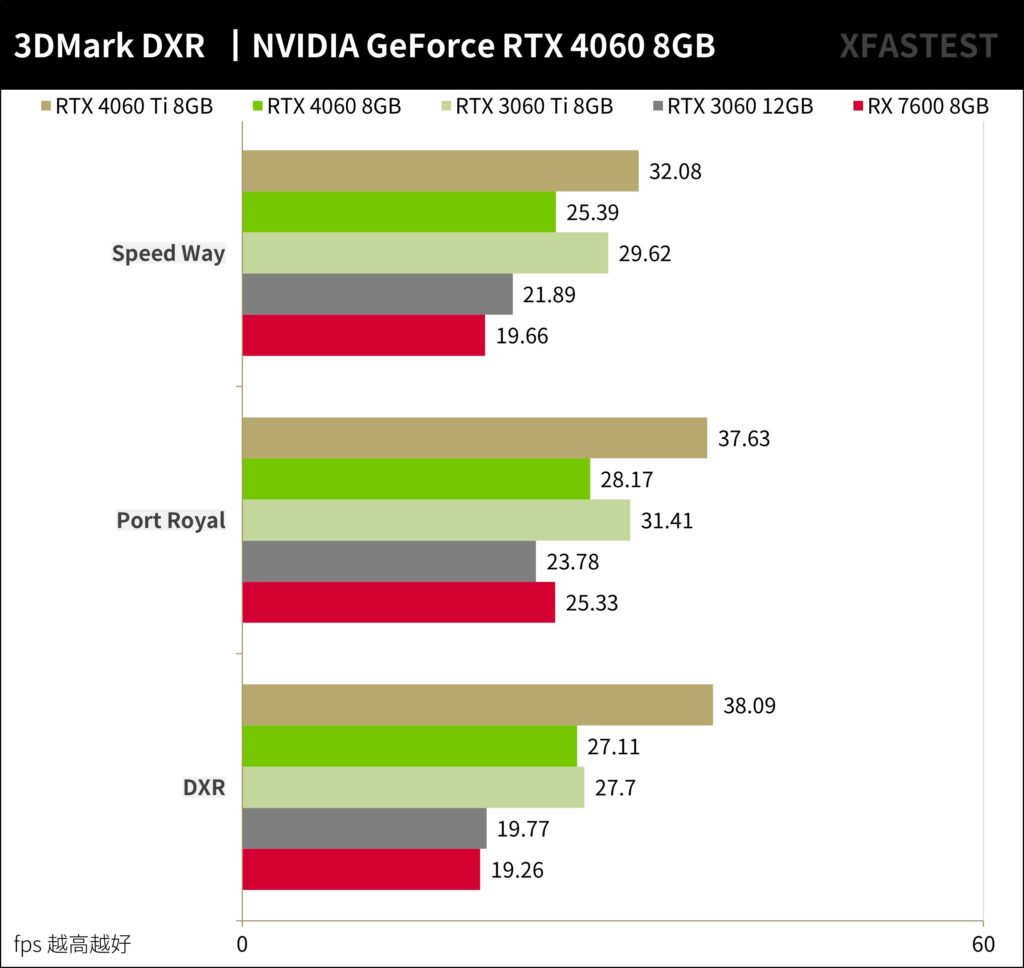
The 3DMark DLSS Feature Test can conduct performance assessments for both DLSS 3 and DLSS 2. It’s set at a resolution of 2560 x 1440 with Performance acceleration enabled.
The RTX 4060 achieves approximately 72.16 FPS, which translates to a 2.5x performance boost with DLSS 2. With DLSS 3, utilizing AI frame supplement technology, it achieves approximately 99.37 FPS, a performance improvement of about 3.5x.
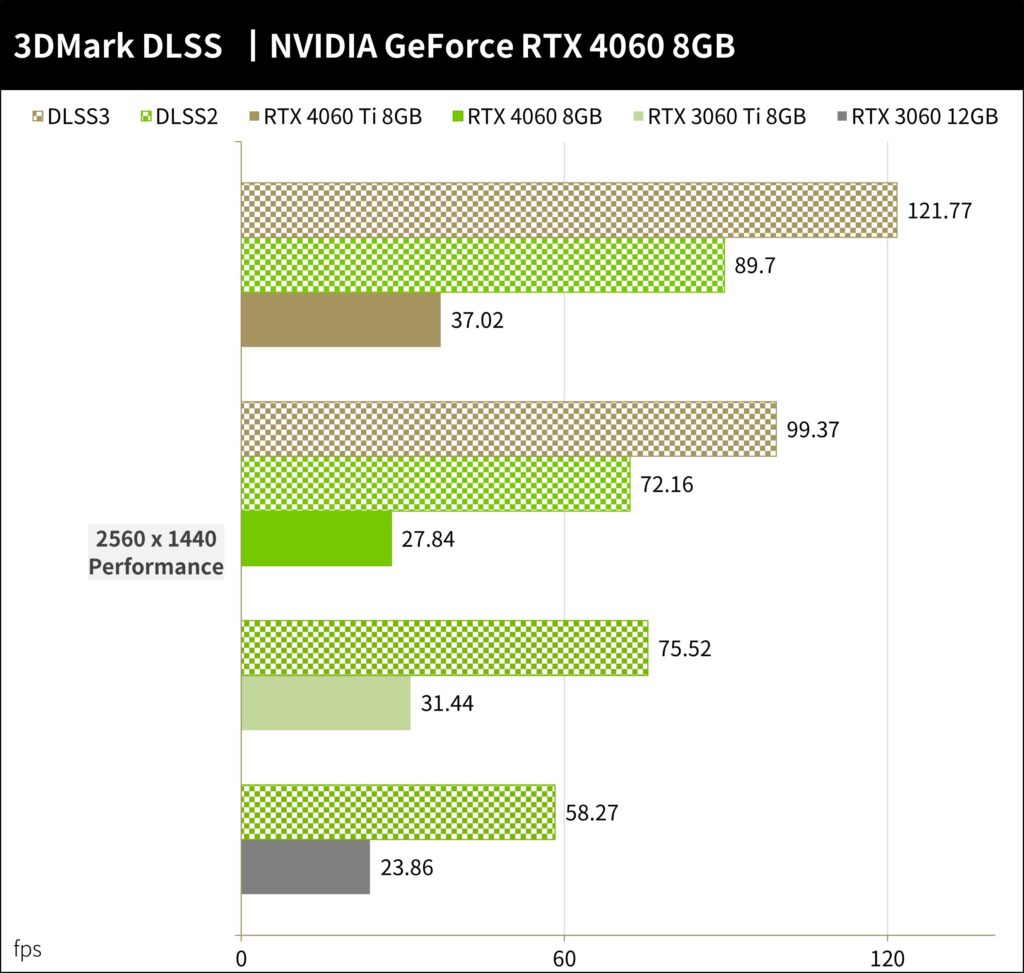
RTX 4060 Ventus 2X Black 8G OC – 4 e-sports games performance test
The four e-sports games “Rainbow Six: Siege,” “League of Legends,” “Apex Legends,” and “CS:GO” rely heavily on skill, team tactics, competitive shooting, and DOTA-style gameplay. Even when the game quality and details are not at their highest, the game FPS still averages over 100 frames. Testing was conducted at 1080p/1440p with the highest special effects setting.
When it comes to e-sports games, the RTX 4060 has more than sufficient performance at 1080p, and even 1440p isn’t an issue. However, in games like “CS:GO”, the previous generation RTX 3060 Ti outperforms it. If your focus is solely on e-sports games, sticking with the more cost-effective previous-generation cards is still a worthy choice.
The RTX 4060, however, finds itself in an awkward position when compared to the current RTX 3060 Ti at the same price. If you’re spending around 10,000 yuan and only plan to play e-sports games, the RTX 3060 Ti would undoubtedly be a more cost-effective choice.
RTX 4060 Ventus 2X Black 8G OC – 10 Games Benchmark
The average performance of 10 AAA games was also tested at 1080p / 1440p with all special effects enabled. In this test, only F1 2021 utilizes the ray tracing function, while the rest of the games don’t utilize ray tracing or DLSS acceleration. This is to test the actual traditional rendering game performance of the GPU.
The game test list includes entry-level games such as “F1® 22”, “Shadow of the Tomb Raider”, “Death Stranding”, “The Division 2”, “Horizon Zero Dawn”, and “Diablo IV”, as well as performance-oriented tests like “Borderlands 3”, “Assassin’s Creed: Valhalla”, “Red Dead Redemption 2”, and “God of War”.
At 1080p resolution, the RTX 4060 achieved an average performance of 145.5 FPS in “Diablo IV”, 70.6 FPS in “Red Dead Redemption 2”, and 72 FPS in “God of War”. Across the 10 games tested, the RTX 4060 had an average performance of 109.43 FPS.
After compiling the results of the 1080p AAA games, the RTX 4060 averaged 109.43 FPS across the 10 games. This represents a 16% improvement compared to the RTX 3060 12GB’s average of 94.47 FPS. It was -9% compared to the RTX 3060 Ti 8GB’s average of 120.13 FPS. Against the RX 7600’s average of 107.10 FPS, it had a slight 2% performance lead. However, it fell behind the previous RTX 4060 Ti, which averaged 129.62 FPS, by -16%.
At a resolution of 1440p, the performance of the RTX 4060 falls short in games such as “F1® 22” with an average of 48 FPS, “Red Dead Redemption 2” with an average of 56.1 FPS, and “God of War” averaging 59 FPS. However, players can employ DLSS to accelerate the RTX 4060, which can then serve as an entry-level 2K 1440p gaming card.
Looking at the results for the 1440p AAA games, the RTX 4060 averaged 77.47 FPS across the 10 games. This is a 15% increase compared to the RTX 3060 12GB’s average of 67.65 FPS. In comparison to the RTX 3060 Ti 8GB’s average of 89.92 FPS, it is behind by -14%. It surpasses the RX 7600’s performance by 4%, but falls short of the previous RTX 4060 Ti, which averaged 94.37 FPS, by -18%.
RTX 4060 Ventus 2X Black 8G OC – 9 Ray Tracing Game Tests
Nine ray-tracing DXR games, including the best game of the year “The Witcher 3: Wild Hunt”, the recent “Star Wars Jedi: Fallen Order”, “Hogwarts Legacy”, along with games like “Cyberpunk 2077”, “Control”, “Spider-Man: Miles Morales”, “Marvel’s Guardians of the Galaxy”, “Far Cry 6” and others, were tested.
Although “Microsoft Flight Simulator” doesn’t support ray tracing, it utilizes DLSS 3 acceleration and thus has been included in this chart. The tests were performed at 1080p and 1440p resolutions, with the highest possible settings for special effects/ray tracing, and DLSS acceleration enabled. Detailed settings can be referred to from the chart.
At 1080p resolution with DLSS 3 acceleration, the RTX 4060 provided excellent performance: an average of 78 FPS in “The Witcher 3: Wild Hunt”, 110 FPS in “Hogwarts Legacy”, and 132 FPS in “Cyberpunk 2077”. The average for all nine ray-traced games was 105.9 FPS.
Summarizing the results from the 1080p ray-tracing games, the RTX 4060 averaged 105.9 FPS across the nine games, which is a 47% increase compared to the RTX 3060 12GB’s average of 72.1 FPS. When compared to the RTX 3060 Ti 8GB’s average of 89.8 FPS, it’s ahead by 18%. In comparison to the RX 7600’s average of 58.3 FPS, the RTX 4060 surpasses it by over 82% in performance but falls short by about -14% compared to the previous RTX 4060 Ti, which averaged 123.5 FPS.
In 1440p resolution and ray-tracing game tests, the RTX 4060 may fall short in terms of performance if the game doesn’t support DLSS 3 acceleration. Therefore, it might require a slight reduction in special effect settings or consider using RTX 4060 Ti instead.
When summarizing the results from the 1440p ray-tracing games, the RTX 4060 averaged 79.9 FPS across the nine games, marking a 44% improvement over the RTX 3060 12GB’s average of 55.7 FPS. In comparison to the RTX 3060 Ti 8GB’s average of 68.0 FPS, it was 17% ahead. The RTX 4060 outperformed the RX 7600, which averaged 41.6 FPS, by over 92% in terms of performance, but fell short by about -13% compared to the previous RTX 4060 Ti’s average of 91.5 FPS.
RTX 4060 Ventus 2X Black 8G OC power consumption and temperature measurement
Your MSI GeForce RTX 4060 Ventus 2X Black 8G OC’s temperature performance under stress tests is indeed commendable. Maintaining a peak temperature of 66.5°C is quite impressive for a compact ITX graphics card that only measures 19cm and utilizes dual fans.
As for power consumption, the specifics weren’t provided in your message. However, if you’re comparing the RTX 4060 with other graphics cards like RTX 3060 12GB, RTX 4060 Ti, RTX 3060 Ti, and RX 7600 using NVIDIA’s PACT tool to monitor power usage, you’re ensuring a fair comparison under consistent conditions.
These aspects are vital considerations for gamers when selecting a new graphics card, particularly for those who are conscious of thermal performance and power consumption, and who may be utilizing smaller, more compact ITX builds where effective heat management is essential.
The MSI GeForce RTX 4060 Ventus 2X Black 8G OC does indeed seem to offer significant power savings compared to its predecessors and competitors, according to your tests. With an average power consumption of 128.5W during the Time Spy Stress test and a maximum of 121W during the Furmark 2K Xtreme burn-in test, it uses significantly less power than the RTX 3060 Ti at 195W and the RTX 3060 at 168.6W.
These results further emphasize NVIDIA’s ongoing improvements in power efficiency with each new GPU generation. Lower power consumption not only leads to reduced electricity costs over time, but it also generates less heat, which can be beneficial for the longevity of other components and overall system stability, especially in smaller ITX builds.
However, it’s always important to consider power consumption in relation to performance. A more power-efficient card that still delivers the required performance can be an excellent choice, particularly for users who are environmentally conscious or those wanting to manage their energy costs.
Summary
Thanks for the comprehensive analysis. The NVIDIA GeForce RTX 4060 does indeed seem like a worthy consideration for gamers on a budget who are interested in running games at 1080p with a solid frame rate. With a price starting at NT$10,690 and strong power efficiency, it does represent a good value proposition, particularly for newer games that can take advantage of DLSS 3.0 for a performance boost.
However, as you pointed out, the RTX 3060 Ti, with a relatively minor price difference (at NT$10,990), offers superior performance in AAA games, even if it does consume more power. For players who want to push their games a little further, especially if they are not primarily interested in ray-tracing or don’t have games with DLSS 3.0, the RTX 3060 Ti does seem to offer better overall value.
In conclusion, the RTX 4060 is a viable choice for budget-conscious gamers, especially those focused on 1080p gaming, and can take advantage of DLSS 3.0. However, for those looking to extract a bit more performance and don’t mind spending a little more, the RTX 3060 Ti seems to be the better option. As always, the best choice depends on each individual’s needs, preferences, and budget.
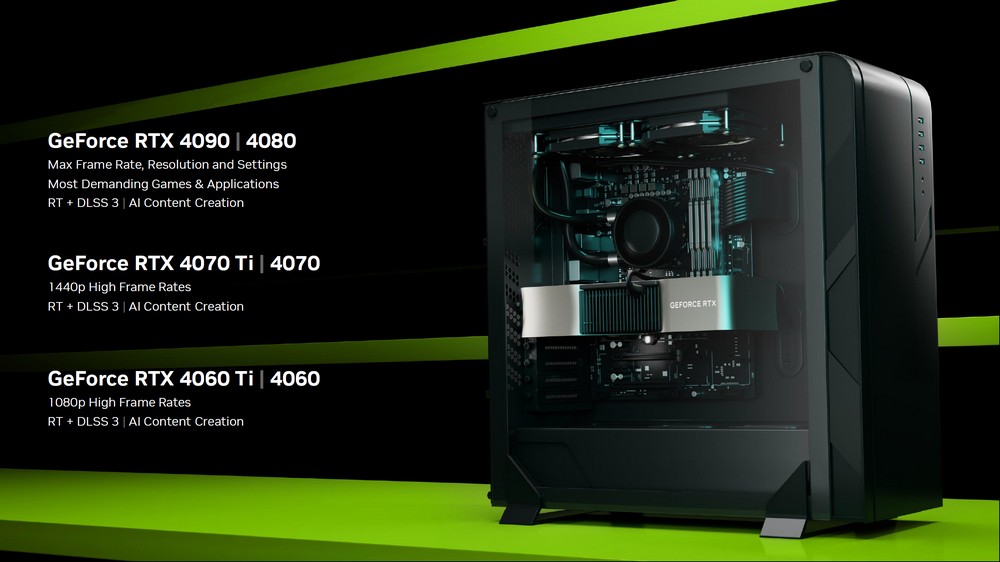
Absolutely, the RTX 40 series offers a wide array of options for gamers at all levels. The top-tier RTX 4090 and RTX 4080 are well-suited for enthusiasts seeking 4K gaming and heavy graphical workloads. The RTX 4070 Ti and RTX 4070 offer excellent performance at a slightly more accessible price point, making 2K gaming and some 4K gaming more accessible for a broader audience. The RTX 4060 Ti and RTX 4060, being more cost-effective options, aim at providing solid performance for 2K and 1080p gaming respectively.
However, even amidst this new lineup, the RTX 3060 Ti and RTX 3060 do indeed stand out for their cost-effectiveness. These cards offer excellent performance for their price and are a great choice for gamers looking to get solid performance without breaking the bank.
Ultimately, each player must evaluate their needs, preferences, and budget to make the best decision. Factors such as the type of games they play, the performance they seek, their monitor resolution, and their future upgrade plans all play a role in choosing the most suitable graphics card.
If this article is helpful for you, please share this article with your friends on social media. Thank you!
This article is based on the personality of the reviews. You are responsible for fact-checking if the contents are not facts or accurate.
Title: Initiating DLSS3 with the first among 10,000! Here’s an evaluation of the NVIDIA GeForce RTX 4060 8GB / Who can justify its cost for 1080p performance